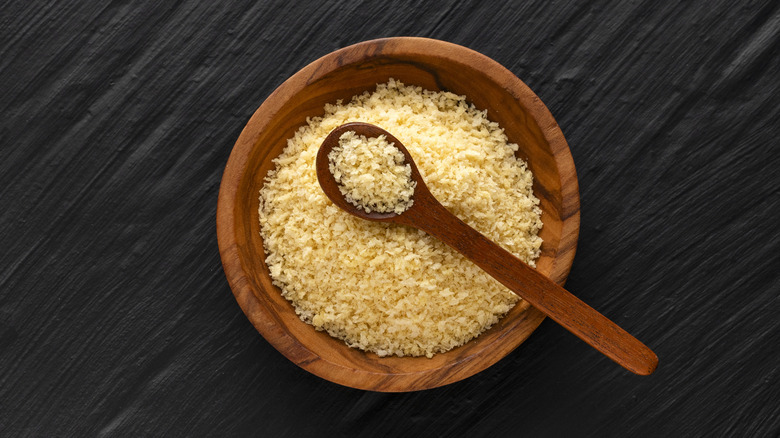The Best Breadcrumbs To Use For The Crispiest Chicken Katsu
We may receive a commission on purchases made from links.
Chicken katsu exemplifies the style of Japanese cooking known as yōshoku, a distinctly Japanese take on Western-style foods developed in the 19th century. It, along with pork katsu (Japan's answer to the Midwestern breaded pork tenderloin), is a popular entree at yōshoku restaurants. It's also something you can make at home, but if you do, "Maricel's Simply Asian Cookbook" author Maricel Gentile insists that you need a specific ingredient. While panko and regular breadcrumbs are interchangeable in many cases, in her opinion, chicken katsu is not one of those dishes. "Japanese panko is the best choice," she said.
As Gentile explained, "Its large, airy flakes make a crust that is crisp but not heavy. Because panko absorbs less oil than regular breadcrumbs, the coating stays golden and light instead of greasy." Fortunately, panko breadcrumbs are just as easy to find on grocery store shelves as regular breadcrumbs. It's also possible to make DIY panko by cutting the crusts off sliced white bread (the cheapest supermarket brand is fine). The bread is then ground up in a food processor, and the crumbs are baked in the oven for about 10 minutes. Another homemade hack involves baking bread slices until they are thoroughly dried out, then reducing them to crumbs with a box grater.
More tips for extra-crispy chicken katsu
Once you have the necessary panko breadcrumbs on hand, there are a few more steps you can take to make sure the chicken katsu comes out with an exceptionally crunchy crust. "I like to add a touch of cornstarch to the flour dredge," shared Maricel Gentile. "It dries the surface so the egg sticks better, and it makes the crust extra crisp." After the cutlets are coated, she dips them in egg once more and then adds a second layer of crumbs to make the coating thicker and crunchier.
The final step involves frying the chicken cutlets. Gentile recommends the oil temperature be between 340 and 350 degrees Fahrenheit, so a product like the Efeng deep fry thermometer is highly recommended. You should also choose an oil with a sufficiently high smoke point. Skip olive oil when frying chicken, since its smoke point can be as low as 325 degrees Fahrenheit. Canola or vegetable oil will work because they won't start smoking until 400 degrees Fahrenheit.
Keep an eye on the thermometer as you fry to ensure that the temperature remains steady. "Too hot, and the coating burns before the chicken cooks through. Too low, and the crust soaks up oil and turns soggy," warned Gentile. To ensure that the pan isn't overcrowded, which can lower the oil temperature, you may need to cook your katsu in batches. As you remove the cutlets from the pan, Gentile advised, "Place the katsu on a wire rack, not paper towels, so the steam escapes and the crust stays crisp."

